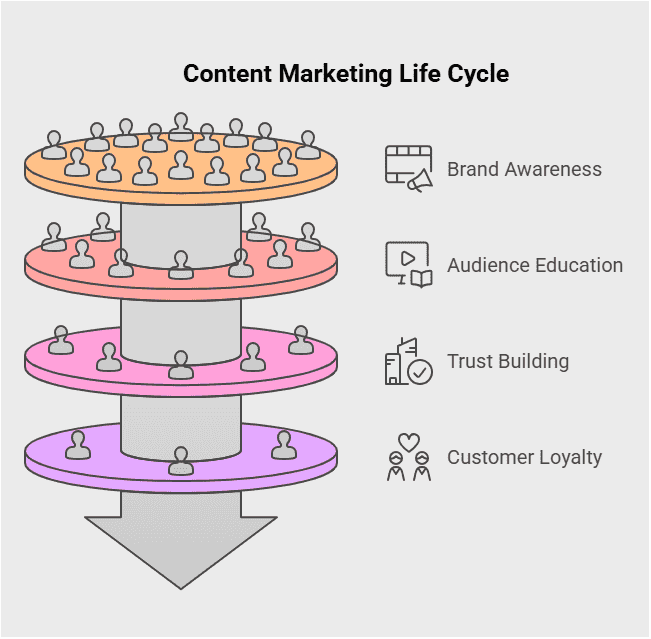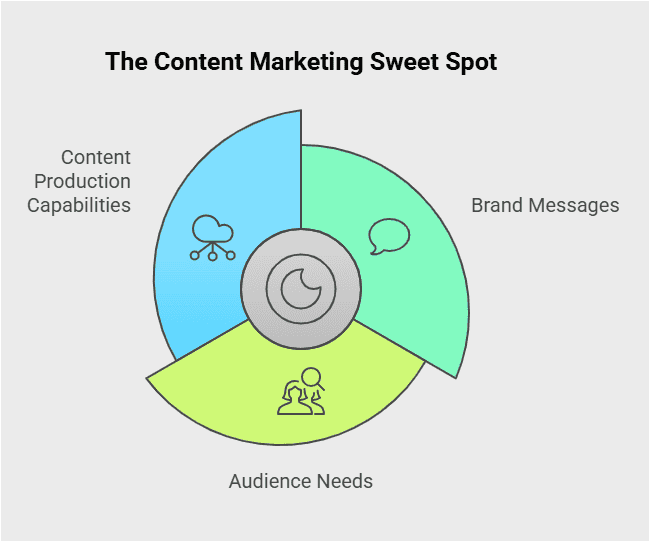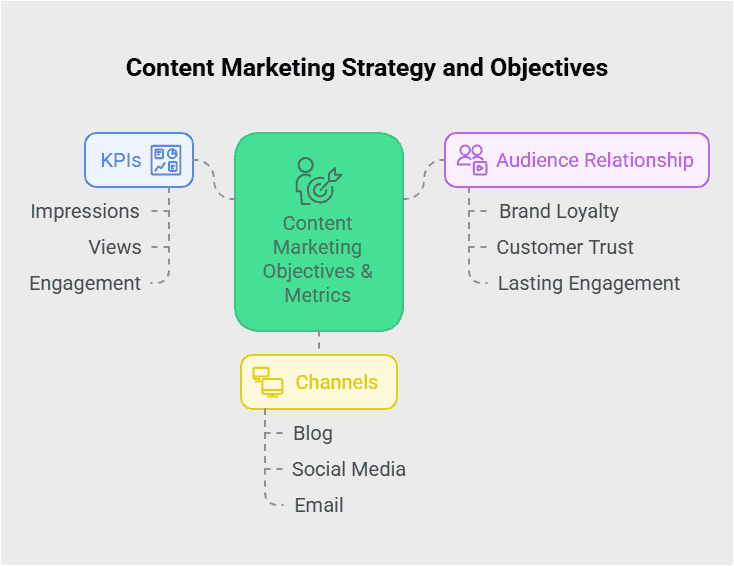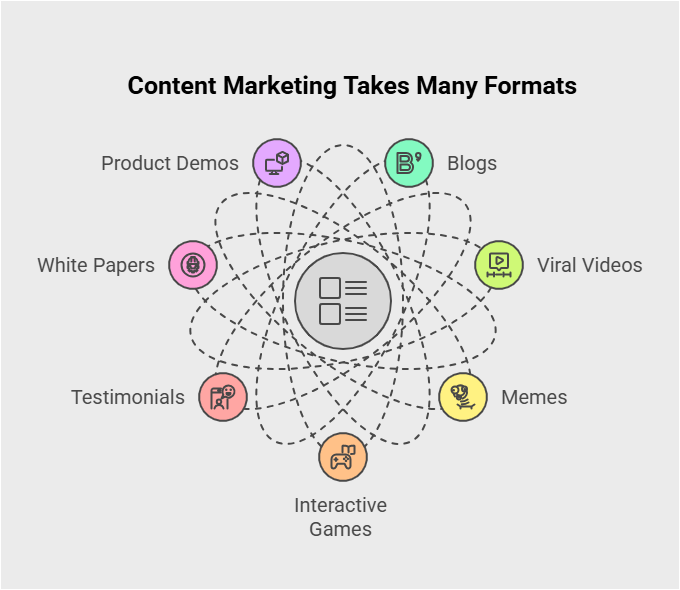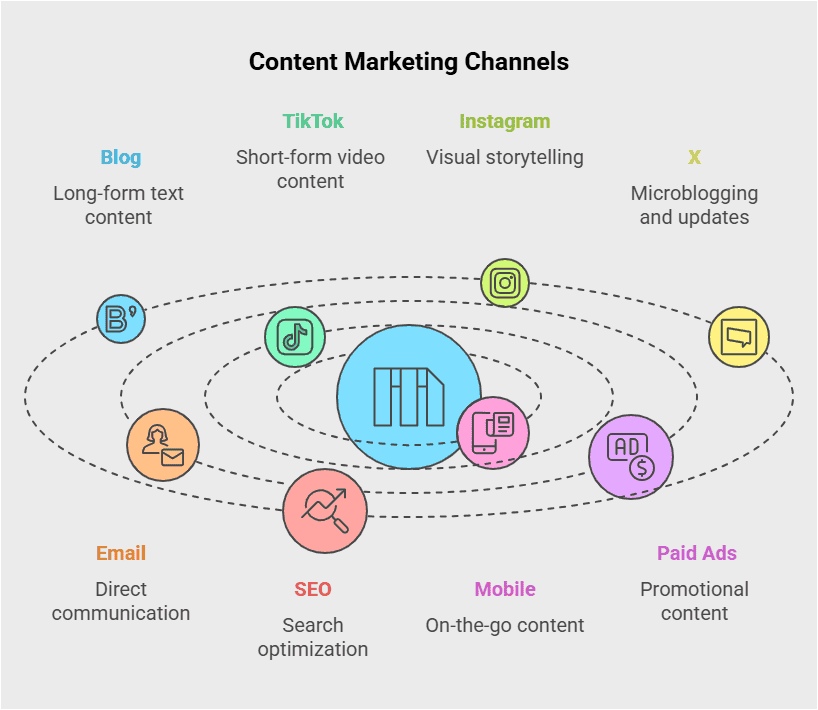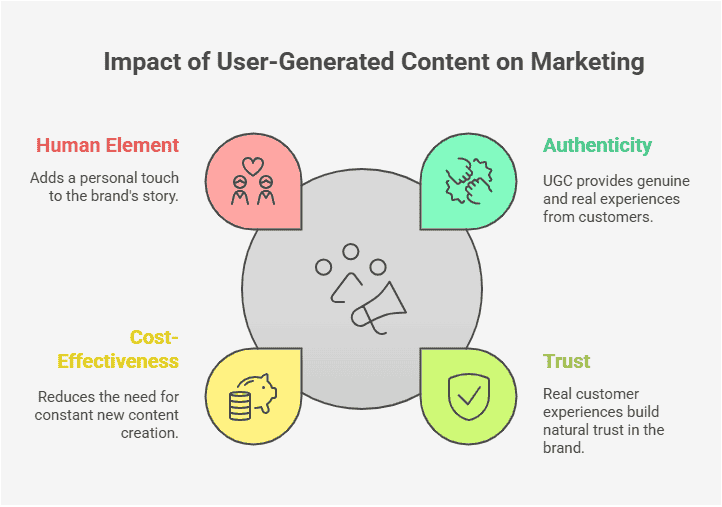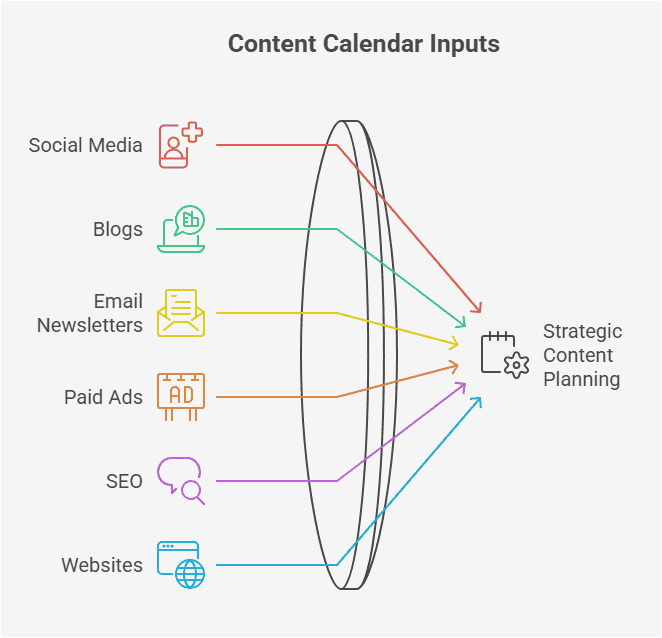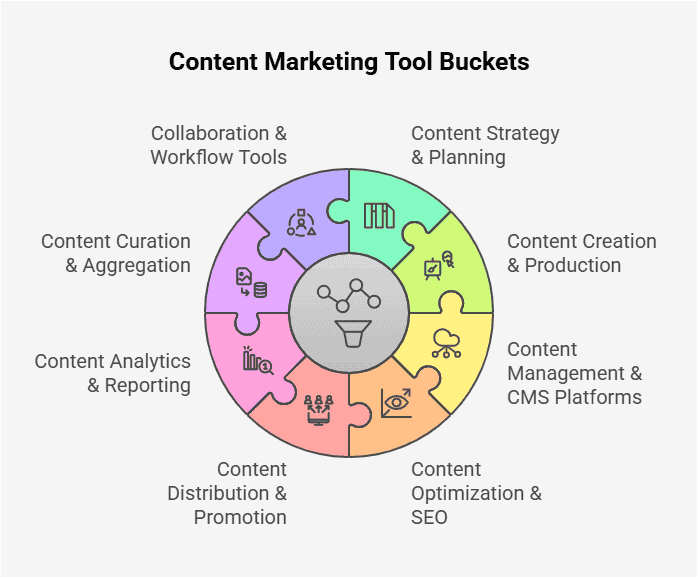Content Marketing Strategy: Tell your brand story
What is Content Marketing?
Content Marketing is the process of creating valuable and interesting content for a specific audience. This content is useful at all stages of the customer journey. It is an essential part of your digital marketing strategy.
Implementing content marketing means you are telling a story about your organization or brand online.
It helps people learn about your brand. It also helps them become loyal fans. It’s not about selling a product or service, it’s about engaging and educating your audience throughout their journey.
By offering valuable insights, useful information, or entertaining content, you build a relationship that takes potential customers from initial discovery to brand advocacy.
Quality content created consistently makes your brand an authority on your topic. When you become a trusted resource and expert in your field it is because you are producing high-quality content consistently. Trust is a major factor in buying decisions. Customers will buy from a brand they perceive as knowledgeable, reliable, and dedicated to their needs.
Consistently creating content is the key to building and maintaining that trust. It requires a clear strategy that incorporates your audience personas. You must know your audience’s needs and align your message with their interests / pain points at every stage of the buying process. Whether it’s blog posts, videos, podcasts, or social media posts, each piece should add value and reinforce your brand’s expertise.
Good content marketing builds trust and knowledge. This helps increase sales and encourages long-term brand loyalty and support. When done right, it doesn’t feel like marketing at all.
Content Marketing Sweet Spot
The content marketing sweet spot is where your brand messages, audience needs, and content production capabilities meet. When you can consistently produce content that resonates with your audience and creates value without stretching your resources.
Great content marketing has three key elements. First, you need to know the messages or stories you want to tell. This means having a clear idea of your brand narrative and the unique insights or experiences you want to share. Whether it’s educating or entertaining your audience, clarity in your storytelling is the foundation of great content.
Second, you need to figure out how to deliver content that’s valuable to your target audience. Knowing your audience’s needs, interests, and challenges allows you to tailor your content to inform, inspire, or solve a problem. Valuable content builds trust, engagement, and long-term loyalty with your audience. Customers make a purchase decision from brands they trust.
Third, you need to know the content you can realistically produce. Even if you have ambitious and innovative ideas, you need to consider your budget, resources, and skills. Marketing teams can’t produce every piece of content they imagine, so focusing on what you can do well is key.
By combining these three elements, defining clear messages, ensuring audience value, and aligning with your production capabilities, you find your content marketing sweet spot. This balanced approach not only maximizes your reach and engagement with your audience but also provides a sustainable content strategy over time. Ultimately it’s about producing authentic and impactful content that reinforces your brand and provides value for your audience that you can produce consistently.
Content Marketing Objectives
Content marketing is a long-term strategy and sometimes your objectives aren’t always clear. You are building a long-term relationship with your customers. It is slow and steady.
However, as time goes on you can use KPIs to measure your strategy. Impressions, views, and engagement (likes, shares, comments) will give you an idea of how your content is resonating with your audience across platforms. These will give you insight into what topics and content formats work best and you can adjust accordingly. Just remember that the outcomes of content marketing aren’t always immediate.
The impact of your efforts unfolds slowly over time as your audience relationship deepens and your content marketing strategy spans multiple channels / digital strategies: website/blog, social media strategy, email marketing strategy, paid ads, and more.
Each contributes to the overall story of your brand. While individual metrics give you performance snapshots, the ultimate goal is to build a long-term relationship with your target audience.
This relationship is measured not just in numbers, but in brand loyalty, customer trust, and lasting engagement. So start with consistency and authentic messaging and add more KPIs as your content strategy matures. This balanced approach will give you growth and meaningful connections with your audience.
Content Marketing Formats
A key factor of successful content marketing is recognizing that content can, and should come in various formats. Some people love reading in-depth blog posts, while others might prefer watching a quick, entertaining viral video, listening to a podcast, or scrolling through a funny meme.
There’s no one-size-fits-all when it comes to how your audience consumes information. By offering content in different forms, whether it's blogs, viral videos, memes, interactive games, heartfelt testimonials, case studies, technical white papers, or detailed product demos, you’re more likely to capture the attention, engage diverse audience segments, and increase your conversation rate.
Also, the type of content you need to create often depends on where your audience is in their customer journey. At the very top of the funnel, where the goal is to spark interest and build brand awareness, formats like viral videos, memes, and games work brilliantly. They grab attention quickly and can make your brand memorable in a fun, engaging way.
Later on, when your audience is deeper into their decision-making process, formats such as testimonials and product demos become more effective. These content formats provide valuable information and help to foster trust, making them ideal for those who are ready to make a purchase.
Using a mix of content formats not only caters to different learning styles and preferences but also increases overall engagement and retention.
When you track the performance of each content type, you gain valuable insights into what resonates most with your audience. This data allows you to refine your strategy, allocate resources wisely, and invest in the channels that drive the best results.
Ultimately, adopting a balanced approach that combines multiple content formats, clear objectives, and measurable metrics will set you up for long-term success while deepening the connection between your brand and your audience.
Content Marketing Channels
This balance of creativity and data-driven analysis not only eases the pressure of constant content creation but also builds a loyal, engaged community. Over time, this strategic alignment between platform demands, audience needs, and measurable outcomes fosters sustainable growth, positioning your brand as both authentic and authoritative in your industry.
The content format must also adapt to the unique requirements of each platform. For example, short-form video platforms like TikTok demand quick, visually engaging content that captures attention instantly, often leveraging trends or storytelling to connect with viewers. In contrast, blogs thrive on long-form, educational articles enhanced with visuals, videos, or infographics to establish authority and provide lasting value.
Email campaigns need short, clear messages that encourage quick actions. These actions can include purchases or sign-ups.
Industry websites might require complex product descriptions or downloadable whitepapers. You must match the content format with the right platform.
A channel-specific approach ensures content remains relevant and impactful. Set clear goals for each platform. For example, aim to boost brand awareness on Instagram or generate leads through email. By tracking the right metrics, you can change your messaging to connect better with your audience.
What is User Generated Content (UGC)?
User-generated content (UGC) is a game changer in content marketing because it brings a level of authenticity and trust that you just can’t buy. When people see existing customers sharing their genuine experiences with your brand, it builds trust naturally.
It’s not just about cutting down on the costs and stress of constantly creating new content, the true magic of UGC is how it adds a genuine, human element to your brand’s story. When a happy customer is snapping a photo with your product or sharing a video review on social media platforms; these moments connect with people on a deeper level than even the most polished ad.
UGC also has the power to boost your reach organically and increase brand awareness. When your audience makes and shares content about your brand, they become ambassadors.
They introduce you to their own networks. You do this without spending money on ads. This type of word-of-mouth promotion can drive real engagement, enhance your credibility, and even help build a vibrant community around your brand.
In addition to saving costs, UGC is a valuable metric in itself. The amount and quality of UGC can signal trust to potential customers and further strengthen your brand’s reputation. Ultimately, blending professionally produced content with user-generated pieces creates a sustainable content strategy. This balanced approach not only eases the pressure of constant content production but also keeps engagement high, paving the way for a loyal and active audience over time.
Content Calendar
A content calendar also fosters collaboration, ensuring all contributors—writers, designers, SEO specialists—are aligned on deadlines and priorities. It helps teams track campaigns, repurpose existing content, and analyze performance to refine future strategies. By integrating these elements, the calendar becomes more than an organizational tool; it transforms into a dynamic asset that drives engagement, supports marketing KPIs, and adapts to real-time needs.
Ultimately, a content calendar empowers brands to deliver value to their audience while staying focused on overarching business goals.
A content calendar is a strategic tool used by marketers and content creators to plan, organize, and schedule content across platforms like social media, blogs, email newsletters, and websites.
Acting as a roadmap, it outlines what content will be published, when it will go live, and where it will appear. This structure ensures consistency, aligns content with business objectives (such as brand awareness, lead generation, or customer retention), and streamlines production workflows. By visualizing timelines and deliverables, teams avoid last-minute scrambles and maintain a cohesive message.
Scheduling content in advance is critical for consistency, which builds audience trust and engagement. However, flexibility is equally important. A well-designed content calendar reserves space for spontaneous posts—like reacting to trends, news, or audience feedback—or accommodating urgent requests from stakeholders (e.g., promotions, partnerships, or crisis communications). This balance prevents the calendar from becoming rigid, allowing teams to stay agile without derailing long-term goals.
Content Marketing Tools
To create great content, you need digital marketing tools. Also, known as a marketing stack. When planning your content marketing stack, it’s helpful to think about “big buckets” or categories that address each phase of your content’s lifecycle. Here are the important buckets and why you need them.
Content Strategy & Planning
Content Creation & Production
Writing and editing, graphic design, video creation, and multimedia production.
Examples: Google Docs/Microsoft Word and ChatGPT for writing, Canva/Adobe Creative Suite for visuals, and video editing software like Adobe Premiere or Final Cut Pro.
Content Management & CMS Platforms
Organizing, managing, and publishing content on websites or blogs.
Examples: WordPress, Drupal, Contentful, or HubSpot CMS.
Content Optimization & SEO
Keyword research, on-page SEO analysis, readability scores, and content performance enhancements.
Examples: SEMrush, Ahrefs, Moz, Yoast SEO, and Clearscope.
Content Distribution & Promotion
Scheduling and publishing to various channels, email marketing, social media management, and advertising.
Examples: Buffer, Hootsuite, Sprout Social, Mailchimp, and social ad platforms like Facebook Ads Manager.
Content Analytics & Reporting
Tracking performance, measuring engagement, conversion tracking, and data visualization.
Examples: Google Analytics, HubSpot, Kissmetrics, and social media insights tools.
Content Curation & Aggregation
Discovering relevant content, gathering industry news, and sharing third-party content.
Examples: Feedly, Pocket, and Curata.
Collaboration & Workflow Tools
Enabling teams to work together seamlessly, review processes, and version control.
Examples: Slack & Microsoft Teams for communication, Google Workspace for collaboration, or project management tools like Monday.com.
Each of these buckets supports a different part of your content marketing ecosystem. Depending on your team size, budget, and specific goals, you might choose specialized tools in each area or opt for platforms that offer an integrated solution. The key is to ensure that your tools help streamline processes from ideation to measurement, ultimately making your content more effective and easier to manage.
Content Marketing Examples
Content marketing done right means that to your audience, it shouldn’t feel like marketing. As long as you create content that is easy to find and provides value to your audience, you are going to win the content marketing long game.
So how do you know if your content is good or not? Using the T.I.R.E. model when evaluating your content will get you closer to your long-term goals. Ask yourself the question, is my content:
Timely
Informational
Relevant
Engaging
I have over 20 years of experience building content marketing strategies that work, most of it done in Ottawa, Ontario, Canada. If you are looking for an Ottawa content marketing consultant, we should talk.
Here are some content examples that I am proud of and that fit the description above.

